A light has gone out of the world. Richard Giles Guthrie died, aged 70, about January 18, 2020, at his home in McClellanville, South Carolina.
Since 2010, he had worked at the American College of the Building Arts in Charleston, where he was credited with re-building the Blacksmithing Specialty. He was deeply and personally invested in cultivating the skills of his students, though he sometimes struggled to connect with those who lacked his own passion for the trade. He admired and rejoiced in the superb hand-eye coordination that came easily and naturally to a select few of his pupils. Yet he was equally proud of those who traveled a far commoner route to exceptionalism: that of open-mindedness, close observation, commitment, perseverance, and long, hard hours of grueling practice. He demanded a lot of his students. They gave him a lot in return.
By nature and inclination, he was a traditional blacksmith, one who aspired to understand and replicate the skills and techniques of historical smiths. He could sit and hold an 18th-century axe or kettle for hours at a time, marveling at the sheer beauty of its form and obsessively pondering how it had been achieved. He then went straight to his forge and put his hypotheses to the test, pounding, tweaking, tinkering, and noticing --- with very fiber of his being ---- where each blow was taking him, while simultaneously planning the next stroke.
For all these reasons, collectors, antiquarians, history buffs, and re-enactors coveted his pieces, many finding them indistinguishable from their ancient models. Although he was proud of such recognition, he also shrank from limelight, and many examples of his work now circulate unmarked, their earnest maker overlooked or forgotten. Savvy collectors and smiths enjoy many a friendly but spirited debate over whether such-and-such a piece is “a Guthrie.”
Many fondly accused him of having “one foot in the past.” (He himself was more inclined to think he had both of them there.) He was a discerning, self-taught architectural historian, who roamed the countryside ferreting out venerable structures to absorb and admire. These included some of America’s best-known and impressive monuments, such as Richmond County, Virginia’s monumental “Mt. Airy.” But perhaps he reserved his deepest reverence for the once-numerous, now-rare vernacular structures erected or originally inhabited by yeoman farmers, indentured servants, and even slaves. He was a great champion of the common man and rejoiced when, after long years of neglect, academia finally began recognizing the invaluable lessons that modest buildings could teach.
He had the deepest respect for America’s indigenous people and, as with every other aspect of his life, threw himself body and soul into understanding their unique history and development. Thus, he undertook historical re-enacting, sometimes portraying an example of the numerous whites who were raised by Native people. He pored over the small but growing number of Native artifacts acquired by the Colonial Williamsburg Foundation and was instrumental in starting a Native interpretation program there. He traveled great distances, including to Europe, for the privilege of studying Native artifacts in other collections. As with all his interests, his enthusiasm was contagious. One could not leave his company without rushing home and diving headlong into some newly-revealed but heretofore-ill-understood aspect of the American past.
He was more than a cultural historian, though. He loved the natural world, and communications with friends were peppered with allusions to tidal actions, eagle sightings, and wind-swept beaches. He idolized the Charleston area’s pelican population, adopting them as his “spirit birds” and figuratively --- sometimes literally --- honoring them with salutes whenever he saw them. His heart soared when flocks of them flew alongside or in front of his car, as they often did at Shem Creek. Many people dismiss America’s swamps and marshes as “muck,” but Rick had a special fondness for these transitional areas, almost intuitively acknowledging their role as cradles of humankind’s development. His love of coastlands and waterways of all kinds and his respect for pre-industrial methods of getting about and making a living were inspirations behind his acquisition of “Exodus,” the beloved sailboat on which lived for several years on the Sampit River near Georgetown, South Carolina.
Rick was born December 1, 1949, in Miami, Florida, to Richard Giles Guthrie and his wife, Lilyan Clair Rabe Guthrie. He had one sibling, now deceased, Angela Gale Guthrie. His daughter Elizabeth Boendier often brightened his life.
He graduated from Culver Military Institute, Culver, Indiana; Marion Institute, Marion, Alabama; and Auburn University, Auburn, Alabama. He often worked as an independent blacksmith but also spent many years working in various businesses, schools, and organizations, including Conner Prairie, Fishers, Indiana; Green River Rifleworks in Roosevelt, Utah; The Colonial Williamsburg Foundation, Williamsburg, Virginia (1980-1997), and lastly, the American College of the Building Arts. He leaves behind a vast and widespread body of friends and devotees and will be sorely missed.
In leu of flowers, please consider making a donation to https://www.americanprairie.org/our-story or https://rockingtheboat.org/
Or the American Collage of the Building Arts.
https://www.acba.edu/supportacba#mission
Copy and photo from here.

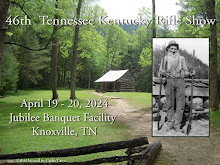

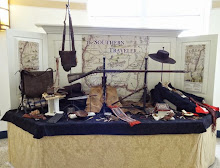





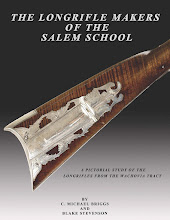

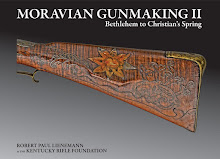


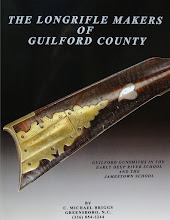

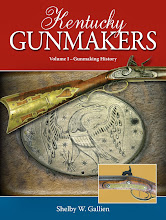









What a wonderful Obituary to a great guy, friend and Artist
ReplyDeleteI only met Rick for a few minutes as I was going in the front door of GRRW, newly arrived apprentice and chatted with him as he was headed out. I believe he was already doing work at Williamsburg at that time in 1977. He struck me as a quiet, kind soul, his former co-workers had nothing but praise for the man.
ReplyDeleteSig Schulz, Dubois WY